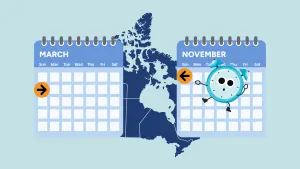
Confused about Canada’s carbon tax? Here's what you should know
In December, 2020 the Federal government announced that starting in 2022 the carbon price rebates will be paid quarterly by cheque or direct deposit.
Putting a price on carbon emissions is the foundation on which a low-carbon economy can be built, according to nearly all economists.
Canada is one of 46 countries to have done so. Carbon pricing has a long history in Canada with Alberta leading the way in 2007 with carbon price on electricity plants and oil-sands facilities. Quebec and British Columbia followed soon after. The simple idea behind carbon pricing is to make emitting carbon costly to encourage energy efficiency as well using and investing in low or zero carbon alternatives.
In the US major corporations, including oil companies, are lobbying for a National Carbon Fee and Dividend system. A steadily rising carbon price whose revenues are returned to the American people would cut US emissions in half by 2036 and boost the GDP by US $190 billion per year, a study found.
Here’s an example of how pricing can shift our choices:
Raise price of beer $5.
Return $5 to buyers.
Sales of wine go up, beer goes down.
The federal carbon price started in 2019 at $20 per ton of carbon dioxide emitted and is now $40 per ton. It’s odd to think of carbon pricing as a tax when all of the money is rebated: The carbon pricing system is revenue neutral at the federal level. Yes, 100 per cent is returned to households and businesses. Last year a family of four in Ontario received an average rebate of $448 while an Alberta family got $888 on their 2019 personal income tax returns according to a government estimate. Canadians in rural areas get a 10 per cent top up to reflect the fact there are fewer options to reduce emissions.

Credit: Chinaface. Getty Images.
CARBON PRICING IS CONFUSING BECAUSE CANADA IS COMPLICATED
This being Canada, provinces decide how to implement carbon pricing subject to a minimum amount established by the Federal government. Because Ontario, Manitoba, Saskatchewan, and Alberta choose not to meet that standard, the bulk of the money is rebated directly to their residents, with the balance going to municipalities and businesses. Other provinces and territories use their own carbon pricing systems but they’re all designed to be revenue neutral using either rebates or tax credits to assist residents. Most also offer grants to businesses and municipalities to help reduce their emissions.

Credit: xPACIFICA. The Image Bank. Getty Images.
“People have trouble accepting that carbon pricing is making most of them better off,” says Michael Bernstein, Executive Director of Clean Prosperity, a Canadian climate policy organization. Clean Prosperity’s research shows eight out of 10 Ontario residents made money with only those with incomes over $150,000 paying more, Bernstein says.
“Canadians overwhelmingly support ambitious climate action but don’t have a sense of the necessary steps,” he says.
Carbon pricing is a key cost-effective step endorsed by conservative, market-driven economists. There’s a debate to be had about the details around how carbon pricing is being implemented such as whether more support is needed to offset the higher carbon costs farmers and small business face but not about the concept itself, Bernstein says.
When carbon pricing is explained properly, the majority of people are in favour, he says.
In 2021 carbon pricing will add 8.8 cents/litre to the cost of gasoline in Ontario, Manitoba, Saskatchewan and Alberta. For perspective, the average price of gas in Canada was $1.40/litre in May 2018 and then 78 cents/litre in April of 2020. That’s a decrease of 62 cents when the carbon price was $30 per ton.
YOUR VEHICLE CHOICE
Vehicle choice makes a much bigger difference when it comes to fuel costs. The Natural Resources Canada Fuel Consumption Guide says the 2020 fuel bill for a Toyota Prius hybrid traveling 20,000 km was $1,125, of which $59 was due to the 2020 carbon price. A Dodge Challengers’ fuel bill would have been $4,031, including $213 for the carbon price while emitting 6.5 tons of CO2 from its tailpipe. Choosing to drive a Prius over the Challenger would save $2,900 a year in fuel costs and cut carbon emissions 4.4 tons. Over five years those savings would be nearly $15,000 with an emission reduction of 22 tons of CO2.
Ok, a Prius vs a muscle car is an extreme example. Let’s look at different models of a Chevrolet Silverado pickup truck. Choosing the Silverado with 3.0 litre diesel engine instead of the four-wheel drive model with a 5.3 litre would save $1,218 a year and cut carbon dioxide tailpipe emissions 1.2 tons. And you’d pay $64 less on the cost of the carbon price, meaning more of the rebate would stay in your pocket.
HOME OWNER EFFICIENCY
Natural gas also produces carbon dioxide and the carbon price is 7.8 cents per cubic metre for 2021 in Ontario, Manitoba, Saskatchewan and Alberta. A new, average-sized single detached home in Canada will burn 2,700 cubic metres of gas in one year, so the cost of the carbon price will be $210 (Rebates for 2021 will be between $600 and $1,000 per family of four depending on the province).
Homeowners can improve their homes’ energy efficiency and keep more of the rebate. The Federal government has set aside $2.6 billion over seven years to help reduce the costs of these green renovations. For example, homeowners can get grants up to $5,000 grants as well as free EnerGuide energy assessments to find the best ways to save energy.
In December, 2020 the Federal government announced that starting in 2022 the carbon price rebates will be paid quarterly by cheque or direct deposit. The carbon price will climb to $170 per ton by 2030. That year a family of four in Ontario will get a rebate of more than $2000.
Unlike regulations, carbon pricing gives individuals the freedom to choose. If you can’t, or don’t want to switch to an electric car or make your home more energy efficient, the rebate will cover the carbon costs.
Carbon pricing is a cost-effective and necessary step on the path to reach Canada’s net-zero carbon goals, concludes Bernstein.
Thumbnail credit: Mikael Vaisanen. The Image Bank. Getty Images.










